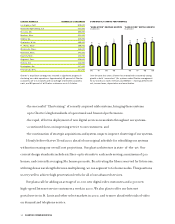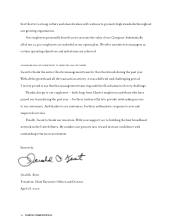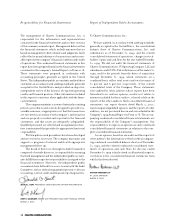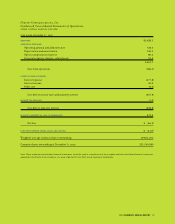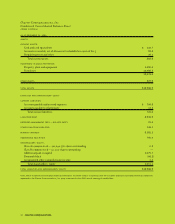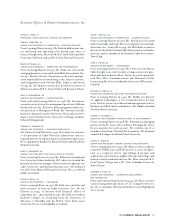Charter 1999 Annual Report Download - page 26
Download and view the complete annual report
Please find page 26 of the 1999 Charter annual report below. You can navigate through the pages in the report by either clicking on the pages listed below, or by using the keyword search tool below to find specific information within the annual report.
24 CHARTER COMMUNICATIONS
ANALOG p. 11
The traditional technology used to transmit video and audio
signals over cable television systems. Contrasts with a
“digital” signal.
BANDWIDTH p. 4
The range of usable frequencies that can be transmitted over a
cable system. Typically expressed in megahertz (MHz).
BROADBAND NETWORK p. 2
A communications system, such as a cable system, with high
bandwidth capacity. It is capable of delivering multiple high-
capacity services, such as Internet access, telephone service,
digital video, and analog video.
CABLE TELEVISION SYSTEM p. 2
A broadband communications network consisting of fiber-
optic cable and coaxial cable that delivers video, data and
telephone services to customers.
CLUSTERING p. 3
Grouping of cable systems in a concentrated geographical area
that are managed as a group in order to achieve operational
efficiencies.
COAXIAL CABLE p. 8
An enclosed wire used for broadband cable communications
systems, having high bandwidth capacity, noise immunity,
and physical durability.
DIGITAL p. 4
Information that has been converted into ‘bits’ of data that
are transmitted through a broadband communication system,
allowing simultaneous transmission of video, voice and data.
DIGITAL VIDEO inside front cover
An enhanced tier of cable TV that offers additional video
channels, multiplexing of premium channels, uninterrupted
music channels and a digital on-screen programming
guide, as well as other enhanced services, through digital
compression technology.
FIBER-OPTIC CABLE p. 5
Thin strands of glass cable used as the medium for transporting
light pulses through a network. Fiber-optic cable is used with
traditional coaxial cable to provide increased bandwidth capac-
ity and improved signal transmission quality and reliability.
HEADEND p. 3
The electronic control center of a cable system. The headend
is the site of the receiving antennae, signal processing
equipment, and other equipment essential to providing
video programming and other communications services to
customers.
HIGH-SPEED INTERNET SERVICE inside front cover
Service of providing high-speed Internet access through
the cable system. It is linked to the customer’s home by a
cable modem.
HOMES PASSED p. 17
The number of homes that could potentially be served by an
existing cable system.
INTERACTIVE p. 2
Two-way communications allowing a customer to both receive
and send information over the cable system.
INTERNET inside front cover
A global data network supporting information, research, edu-
cational, and commercial services. High-speed connection to
the Internet is available through the cable system.
MEGAHERTZ (MHz) p. 8
A measure of bandwidth capacity. Currently, state-of-the-art
cable systems are generally constructed with bandwidth
capacity of 750 MHz or 870 MHz.
MODEM p. 9
An external or internal terminal device that, when connected
with a personal computer and the cable system, transports data
to customers at a greater speed than conventional analog
dial-up modems.
NODE p. 8
The termination point of the fiber-optic cable from the head-
end. Coaxial cable connects the node to individual homes.
PORTAL p. 9
An entrance to the Internet, such as through a broadband or
cable system.
PREMIUM CHANNEL p. 9
A cable channel that is not included in basic or expanded basic
cable packages. Examples of premium channels include HBO
and Showtime.
SWAP p. 14
A trade of cable television systems with another cable
company, generally to improve a company’s clusters.
VIDEO ON DEMAND p. 9
Television programming provided to customers upon request.
Generally, this allows a customer to choose a movie from a
library of films and select the title and start time immediately
on request. It also offers VCR-like features to the customer
during the delivery of the movie.
Page numbers indicate first appearance in text of defined word.
Glossary of Terms


